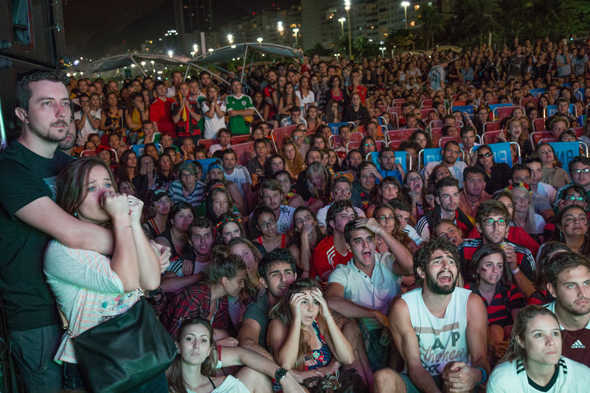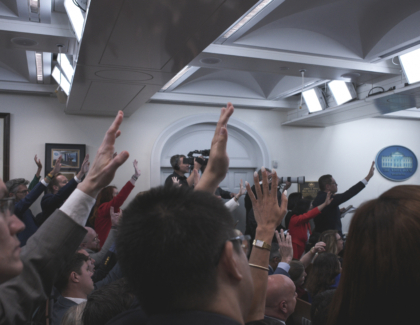Sign up for the daily CJR newsletter.

Freaks! Studies show that self-esteem of sports fans, like these watching the World Cup final, is bound up in their team’s performance. (Susan Meiselas / Magnum Photos)
This summer was tumultuous for the mood of nations, as you may have read in the sports section. In Argentina, Reuters reported, a “weary nation” was able to find “rare joy” in the achievements of its beloved World Cup team. In Spain, with its economic problems and Catalan secessionist rumblings, The New York Times found World Cup elimination hangover: a “mist of mourning” over the country that “spoiled” the arrival of a new king. And Brazil. Before the World Cup, a Bloomberg Businessweek headline wondered, “Have Brazilians lost their love of soccer?” Apparently they still loved it sufficiently for an ESPN writer to find winter rain a portent from the gods as the team crashed out of the tournament. Or maybe not? Fans took to Twitter and the comments to declare themselves glad that the team was losing; four days later, the Times discovered a bunch of Brazilians who seemed just fine—“pleased,” according to the lede, about the outcome, and focused “as much on domestic politics as the event’s final match.” The gods, and the Brazilians, had quickly chased away their emotional trauma.
The World Cup and other major sporting events, like the Olympics or LeBron James returning home, turn sports journalists into travel writers, assigning them the challenging task of describing the character of millions of people based on a handful of interviews. The takeaway of stories becomes, unsurprisingly: Sports exercises a lot of power over some people.
But how? And how much power? And which people? These narratives of fans, identity, and meaning underlie some testable hypothesis about how sports affect people but offer little in the way of empirical backing. Perhaps that’s because numbers would challenge the hypotheses. On the subject of national narratives and soccer, for example: One poll conducted before the start of the World Cup by YouGov and the Times asked people in 19 countries how much they cared about soccer. Now, soccer is a big deal around the world, but of the countries surveyed, only in Colombia did 50 percent say there were “very interested” in soccer. In Brazil, 40 percent said they were very interested, while 47 percent said they were “slightly or somewhat interested,” and 12 percent didn’t care at all. Twelve percent of Brazil’s 200 million people means that there were 24 million people in Brazil who did not weep with the gods over the World Cup results, a Texas-size gap in the narrative. It’s entirely possible, in other words, that the narrative of sports fans and national identity is based on a minority of a country’s people—like the myths of “real” America based around a heartland ideal, resonating somewhere with someone, yet utterly ungrounded in math or reality.
When sportswriters turn inward, “we” and “us” replace “them,” but the form tends to remain the same: broad generalizations based on an n of 1. “As fans, we . . .”; “There’s nothing we love more than . . .”; “Sports fans like to . . . .” You can find dozens of these in any given month, in publications big and small, from writers brilliant and otherwise, in longform and in listicles. Almost all of it is guesswork, narrative simplification that underlies a complex reality. What really lies in the hearts of sports fans? Multitudes, of course; these are human beings and human beings are complicated. But that is a tough narrative to write. So writing about sports fans, like writing about politics, becomes the kingdom of writers remaking the world in their own image.
Bill Simmons, one of the most influential American sportswriters, once wrote after his team lost the Super Bowl, “I have never been able to answer the question, ‘Why does this matter to me so much?’ That’s just the way it’s always been. Ever since I can remember.”
“Why does this matter to me?” is a scientific question. “That’s just the way it’s always been” is a nifty dodge.
These reed-thin forays into pop psychology would seemingly be better informed with a scientific understanding of what motivates sports fans, and therein lies the problem. If there’s one charitable excuse for Simmons and his fellow sportswriters’ failure to ask a scientist, it’s that most researchers don’t know, either. In fact, given all the interest in sports and their fans, there is precious little research on fan behavior. The guy described by most of his colleagues as far and away the leading sports-fan psychologist in North America, Daniel Wann, works out of a small liberal arts college in Murray, KY, receives no grant funding, and never intended to do research, anyway. When I first met him, at an annual sports fan-psychology symposium he hosts with Western Kentucky University’s Rick Grieve—which in 2012 had about 20 attendees, including graduate students (a sign, Grieve suggested earnestly, of the event’s soaring popularity)—I told Wann I was surprised at how few sports-fan researchers there were out there. “Very few,” Wann joked. “Here we are! You’ve met us!”
Psychologists like Wann who have tried to zero in on why people love sports have settled on, at the most reducible level, eight different motivations. Some of them are more common, but none is any more significant than any of the others. People like sports because they get self-esteem benefits from it. People like sports because they have money on it. People like sports because their boyfriend or girlfriend or family member likes sports. People like sports because it’s exciting. People like sports because it’s aesthetically pleasing. People like sports because, like the theater, it is a venue for emotional expression. People like sports because they need an escape from real-world troubles. People like sports because it provides a sense of belonging, a connection to a wider world.
In other words: There is no single answer to why people watch sports, because the answer doesn’t lie in the game, it lies inside the individual. So it’s complicated in the same ways all our relationships are complicated. Even on the rare occasions when sportswriters do attempt to push beyond the platitudes, it is difficult to squeeze an answer into a single narrative. In 2011, for example, Simmons’ ESPN-sponsored site Grantland published “This is Your Brain on Sports,” a long story about the discovery of “mirror” neurons that mimic action in others and underlie our sense of empathy. Before his plagiarism and quote-fabrication scandals, the enormously popular science writer Jonah Lehrer once covered the same territory in his Frontal Cortex blog, writing, “I’d like to propose a cellular mechanism for fandom: mirror neurons.” (Lehrer returned to the “Why Do We Watch Sports” question more recently, in March of this year, writing that he was “most intrigued by the so-called talent-luck theory,” which attributes the appeal of a sport to how well it balances skill and randomness.) Mirror neurons undoubtedly play a role in interpreting the action you see on the field. They may be the mechanism, but they are nonetheless a small part of the answer: Mirror neurons can explain why you put yourself in the shoes of the players on the field. But as Lehrer hints at in his original post, they cannot explain why you put yourself only in the shoes of precisely half the players on the field—your favorite team.
And yet that’s the puzzle we really want an answer to—not just why we care, but why we care so much about one particular collection of athletes, and why that caring seemingly blinds us to so much else. The New York Times has published dozens of stories in the last few years alone that make me question the entire endeavor of sports fandom: the reluctant police investigation into the rape charges against a famous college quarterback; the corruption of governing agencies from FIFA to the NCAA; the links between concussions and contact sports. And yet, I’m still a fan.
So what do scientists know about sports fans that journalists might use to inform their stories, or to understand their subjects? We know one thing definitively: Sports fans are people. They are subject to all the quirks and frailties of human nature. There is no sports-watching part of the brain, so what the brain does, confronted with this thing running around in front of it, is resort to what it knows.
One of those quirks, maybe my favorite, is that the barrier between the self and the outside world is much less defined than it seems. Studies of people in close relationships show that the brain is reliably confused about whether achievements or characteristics belong to the body it inhabits or to another person it is in a relationship with. There is reason to believe that watching sports engages this connection: We connect to our teams, to the players on our teams, to the other fans of our teams. We bask in reflected glory because there is some actual point of contact, at the neural level, between a team’s performance and our own self-esteem.
Fans’ identity, self-esteem, and pride are on the line to some degree in every game. Brazil is an impossibly complex country of 200 million people; you cannot describe it in a single narrative. But it is true that a lot of Brazilians—of all classes and races—care about soccer and are emotionally invested in the national soccer team. And for all of those individual fans, the semifinal loss to Germany caused a wobble in their identity. Like a divorce, or a retirement, something that they had known for years, had adopted as a part of themselves, had collapsed.
In a more collective way, we also know from psychology that people divided into groups behave differently toward, and even unconsciously think differently about, in-group and out-group; sports provide an easy and arbitrary group division. It does not follow, though, that sport is sublimated war—even though one of the most popular narratives about fans is that they’re merely channeling that same my-people aggression, if in a (slightly) more constructive manner. Humans are competitive and oriented toward thinking about the world in groups, but there’s no evidence that sports are a way for us to slake our warlike natures.
We know from endocrinology that our hormones engage when watching sports, as they do in the presence of any competition: testosterone, adrenaline, cortisol, and oxytocin are all active in fans, with some connections better understood than others. Testosterone, the hormone we think of most in relation to sports fans, is a surprisingly complicated hormone. (Interestingly, the definitive testosterone study, which shows that in male fans winning increases testosterone while losing decreases it, comes not from sports but from the 2008 presidential election.)
We do not know that testosterone fuels fan riots and violence—although to be fair, we also don’t know that it does not. (I went to a hockey game with a researcher who studied fan violence. So far, he said, there was only one major takeaway: “The thing that really prevents celebratory violence, the thing that solves it,” he said, “is to have your team suck.”) The evidence, after all, suggests that testosterone drops in losing fans. But from other studies we could reasonably point the finger at a number of non-sports factors: alcohol, expectation, and context. Crowd psychologists say that interaction between fans or protesters and authorities is critically important; police who arrive in riot gear and with batons at the ready tend to get the event they plan for, whether they’re dealing with English soccer hooligans or the Occupy movement.
Between the lack of media and scientific curiosity, though, is a missed opportunity not just to better understand sports fans, but to better understand people. Fans are not monolithic; they are not in thrall to something beyond our understanding, or even acting irrationally: They are just humans being human. Yet writers often suggest fan behavior is something extraordinary, when the evidence suggests that really, it’s not.
Partly what that means is the behaviors so many identify as undesirable in sports fans are malleable. Context and culture matter, immensely, as they do in all human passions. Brian Phillips, who wrote some brilliant columns earlier this year about fans and sports for Grantland, made the point in an essay about the NFL and locker-room bullying. At the time, network analysts and former players were on the air almost daily talking about how there was a locker-room code inspired by male biology, and that to suggest otherwise would go against human nature. (Miller Lite, which has probably done more to inform popular views of sports fans than all of science and journalism on the subject combined, once created a famous series of ads featuring former football players and assorted manly men deciding on “Man Laws.”)
“There are boundaries in locker rooms, same as anywhere else, and those boundaries are culturally conditioned, same as anywhere else, and they change with time, and they can be influenced,” Phillips wrote. “There will always be locker-room assholes. They should be curtailed.”
Fighting fans, rape culture, warrior-male culture, anti-gay culture—these are specific expressions of upbringing, education, and socialization. They may have some biological component to them, but they are not inevitable.
In a separate column wrapping up the World Cup, Phillips turned to art. “Sport is like music or fiction or film,” he wrote, “in that, for a predetermined duration, it asks you to give it control over your emotions, to feel what it makes you feel.”
The art comparison is a good one. Athletes reflect us, and occasionally provide insight into the human condition, and their work is judged by the response to it as much as by its quantitative character. Their work inspires, suggests, provokes. But the science also says that sports speak a different truth to each observer. Each of us puts our self into the story, incorporates the event and its ups and downs into our own narrative. Sometimes, tens of millions of individuals care very much about the same event, and their individual stories collide to create something larger. Whether that collision occurs over Starry Night in the Museum of Modern Art or Michigan football in the Big House, some people thrive on swirls of pure, violent energy and some people just like blue. Assigning them a collective narrative, like assigning a collective narrative to a billion soccer fans, obscures rather than defines the nature of their passion.
Has America ever needed a media defender more than now? Help us by joining CJR today.






